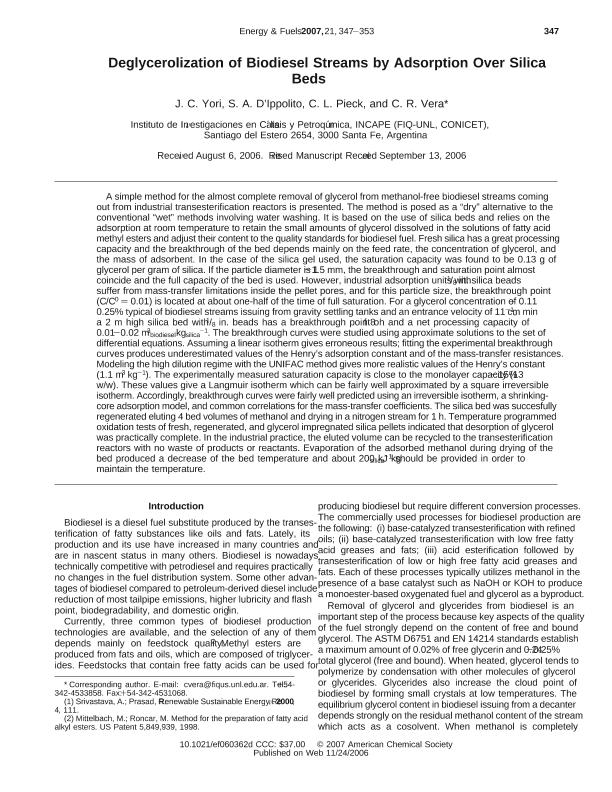Artículo
Deglycerolization of biodiesel streams by adsorption over silica beds
Fecha de publicación:
01/2007
Editorial:
American Chemical Society
Revista:
Energy & Fuels (print)
ISSN:
0887-0624
Idioma:
Inglés
Tipo de recurso:
Artículo publicado
Clasificación temática:
Resumen
A simple method for the almost complete removal of glycerol from methanol-free biodiesel streams coming out from industrial transesterification reactors is presented. The method is posed as a "dry" alternative to the conventional "wet" methods involving water washing. It is based on the use of silica beds and relies on the adsorption at room temperature to retain the small amounts of glycerol dissolved in the solutions of fatty acid methyl esters and adjust their content to the quality standards for biodiesel fuel. Fresh silica has a great processing capacity and the breakthrough of the bed depends mainly on the feed rate, the concentration of glycerol, and the mass of adsorbent. In the case of the silica gel used, the saturation capacity was found to be 0.13 g of glycerol per gram of silica. If the particle diameter is 1-1.5 mm, the breakthrough and saturation point almost coincide and the full capacity of the bed is used. However, industrial adsorption units with 1/8 in silica beads suffer from mass-transfer limitations inside the pellet pores, and for this particle size, the breakthrough point (C/C0 = 0.01) is located at about one-half of the time of full saturation. For a glycerol concentration of 0.11-0.25% typical of biodiesel streams issuing from gravity settling tanks and an entrance velocity of 11 cm min-1, a 2 m high silica bed with 1/8 in. beads has a breakthrough point of 8 h and a net processing capacity of 0.01-0.02 m3 biodiesel, kgsilica -1. The breakthrough curves were studied using approximate solutions to the set of differential equations. Assuming a linear isotherm gives erroneous results; fitting the experimental breakthrough curves produces underestimated values of the Henry's adsorption constant and of the mass-transfer resistances. Modeling the high dilution regime with the UNIFAC method gives more realistic values of the Henry's constant (1.1 m3 kg-1). The experimentally measured saturation capacity is close to the monolayer capacity (13-15% w/w). These values give a Langmuir isotherm which can be fairly well approximated by a square irreversible isotherm. Accordingly, breakthrough curves were fairly well predicted using an irreversible isotherm, a shrinking-core adsorption model, and common correlations for the mass-transfer coefficients. The silica bed was succesfully regenerated eluting 4 bed volumes of methanol and drying in a nitrogen stream for 1 h. Temperature programmed oxidation tests of fresh, regenerated, and glycerol impregnated silica pellets indicated that desorption of glycerol was practically complete. In the industrial practice, the eluted volume can be recycled to the transesterification reactors with no waste of products or reactants. Evaporation of the adsorbed methanol during drying of the bed produced a decrease of the bed temperature and about 200 kJ kgsilica -1 should be provided in order to maintain the temperature.
Palabras clave:
Biodiesel
Archivos asociados
Licencia
Identificadores
Colecciones
Articulos(INCAPE)
Articulos de INST.DE INVEST.EN CATALISIS Y PETROQUIMICA "ING. JOSE MIGUEL PARERA"
Articulos de INST.DE INVEST.EN CATALISIS Y PETROQUIMICA "ING. JOSE MIGUEL PARERA"
Citación
Yori, Juan Carlos; D'ippolito, Silvana Andrea; Pieck, Carlos Luis; Vera, Carlos Roman; Deglycerolization of biodiesel streams by adsorption over silica beds; American Chemical Society; Energy & Fuels (print); 21; 1; 1-2007; 347-353
Compartir
Altmétricas




